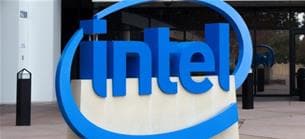Intel vs. Advanced Micro: Which Chipmaker is the Better Buy Now?
Werte in diesem Artikel
Intel Corporation INTC and Advanced Micro Devices, Inc. AMD are two premier semiconductor firms competing in the CPU market, with both focusing on AI (artificial intelligence) and advanced chip technologies. Intel, reportedly the world’s largest semiconductor company and primary supplier of microprocessors and chipsets, is gradually reducing its dependence on the PC-centric business by moving into data-centric businesses, such as AI and autonomous driving. The foundry operating model is a key component of the company's strategy and is designed to reshape operational dynamics and drive greater transparency, accountability and focus on costs and efficiency.Advanced Micro has strengthened its position in the semiconductor market on the back of its evolution as an enterprise-focused company from a pure-bred consumer-PC chip provider. Its processors are primarily powered by the company's proprietary "Zen" CPU and "Vega" GPU architectures. The company’s acquisition of Xilinx has helped in expanding into multiple embedded markets. AMD now offers Field Programmable Gate Arrays (FPGAs), Adaptive SoCs and Adaptive Compute Acceleration Platform (ACAP) products. With growing AI proliferation in PCs, smartphones, automotive and IoT applications, both Intel and Advanced Micro are steadily advancing their semiconductor portfolio to bolster their competitive edge. Let us analyze in depth the competitive strengths and weaknesses of the companies to understand who is in a better position to maximize gains from the emerging market trends.The Case for IntelIntel is strategically investing to expand its manufacturing capacity to accelerate its IDM 2.0 (Integrated Device Manufacturing) strategy. The company is undertaking various strategic decisions to gain a firmer footing in the expansive AI sector. Its latest Xeon 6 processors with Performance-cores (P-Cores) can support large AI workloads across diverse sectors. With industry-leading capabilities in AI processing, the Xeon 6 family delivers the industry’s best CPU for AI at a lower total cost of ownership. Intel's innovative AI solutions are set to benefit the broader semiconductor ecosystem by driving down costs, improving performance and fostering an open, scalable AI environment. The company has received $7.86 billion in direct funding from the U.S. Department of Commerce for its commercial semiconductor manufacturing projects under the U.S. CHIPS and Science Act. The funds will support Intel in advancing critical semiconductor manufacturing and advanced packaging projects in Arizona, New Mexico, Ohio and Oregon, likely paving the way for innovation and growth.However, Intel derives a significant part of its revenues from China. As Washington tightens restrictions on high-tech exports to China, Beijing has intensified its push for self-sufficiency in critical industries. This shift poses a dual challenge for Intel, as it faces potential market restrictions and increased competition from domestic chipmakers. The company is also lagging behind in the GPU and AI front compared to peers such as NVIDIA Corporation NVDA and AMD. Leading technology companies are reportedly piling up NVIDIA’s GPUs to build clusters of computers for their AI work, leading to exponential revenue growth.The Case for Advanced MicroAMD is strengthening its footprint in the AI market through an expanding portfolio. The latest MI300 series accelerator family strengthens its competitive position in the generative AI space. The accelerator is based on AMD CDNA 3 accelerator architecture and supports up to 192 GB of HBM3 memory, enabling efficient running of large language model training (up to 80 billion parameters) and inference for generative AI workloads. It is also benefiting from strong enterprise adoption and expanded cloud deployments.In addition, strength in 7-nanometer-based processors is expected to strengthen the company's competitive position in the commercial and server market against Intel. AMD is currently leveraging Taiwan Semiconductor Manufacturing Company's 7 nm process technology, which is enabling it to deliver its advanced 7 nm chips faster to market. AMD Radeon RX 7900 series chiplet design combines 5 nm and 6 nm process nodes, each optimized for specific chips in the GPU.However, in the traditional computing market, which still generates a chunk of its revenues, AMD is up against Intel's strong market position. With Intel systems so well entrenched, there is an obvious preference for system integrators to choose Intel processors over AMD. Moreover, AMD faces significant competition from NVIDIA in the GPU market. AMD has had relatively greater success in the mobile segment and its current product lineup indicates that this focus will continue. However, competition in the mobile segment is likely to accelerate, with more ARM-based devices coming on the market.How Do Zacks Estimates Compare for INTC & AMD?The Zacks Consensus Estimate for Intel’s 2025 sales implies a year-over-year decline of 4.3%, while that of EPS indicates growth of 323.1%. The EPS estimates have been trending southward on average over the past 60 days.Image Source: Zacks Investment ResearchThe Zacks Consensus Estimate for Advanced Micro’s 2025 sales suggests year-over-year growth of 23.3%, while that for EPS implies a rise of 22.7%. The EPS estimates have been trending southward over the past 60 days.Image Source: Zacks Investment ResearchPrice Performance & Valuation of INTC & AMDOver the past year, Intel has declined 33.8% against the industry’s growth of 14.1%. AMD has lost 33.2% over the same period.Image Source: Zacks Investment ResearchIntel looks more attractive than Advanced Micro from a valuation standpoint. Going by the price/sales ratio, Intel’s shares currently trade at 1.74 forward sales, significantly lower than 5.48 for AMD.Image Source: Zacks Investment ResearchINTC or AMD: Which is a Better Pick?Both Intel and Advanced Micro carry a Zacks Rank #3 (Hold). You can see the complete list of today’s Zacks #1 Rank (Strong Buy) stocks here.Both companies expect their earnings to improve in 2025. However, Intel expects a decline in revenues contrary to that of AMD. Over the years, AMD has shown steady revenue and EPS growth, while Intel has been facing a bumpy road with a downhill slope. With a healthy long-term earnings growth expectation of 24.5%, Advanced Micro is relatively better placed than Intel (long-term earnings growth expectations of 10.5%), although the former is a bit expensive in terms of valuation metrics. Consequently, Advanced Micro seems to be a better investment option at the moment.Only $1 to See All Zacks' Buys and SellsWe're not kidding.Several years ago, we shocked our members by offering them 30-day access to all our picks for the total sum of only $1. No obligation to spend another cent.Thousands have taken advantage of this opportunity. Thousands did not - they thought there must be a catch. Yes, we do have a reason. We want you to get acquainted with our portfolio services like Surprise Trader, Stocks Under $10, Technology Innovators,and more, that closed 256 positions with double- and triple-digit gains in 2024 alone.See Stocks Now >>Want the latest recommendations from Zacks Investment Research? Today, you can download 7 Best Stocks for the Next 30 Days. Click to get this free report Intel Corporation (INTC): Free Stock Analysis Report Advanced Micro Devices, Inc. (AMD): Free Stock Analysis Report NVIDIA Corporation (NVDA): Free Stock Analysis ReportThis article originally published on Zacks Investment Research (zacks.com).Zacks Investment ResearchWeiter zum vollständigen Artikel bei Zacks
Übrigens: Intel und andere US-Aktien sind bei finanzen.net ZERO sogar bis 23 Uhr handelbar (ohne Ordergebühren, zzgl. Spreads). Jetzt kostenlos Depot eröffnen und als Geschenk eine Gratisaktie erhalten.
Ausgewählte Hebelprodukte auf Intel
Mit Knock-outs können spekulative Anleger überproportional an Kursbewegungen partizipieren. Wählen Sie einfach den gewünschten Hebel und wir zeigen Ihnen passende Open-End Produkte auf Intel
Der Hebel muss zwischen 2 und 20 liegen
| Name | Hebel | KO | Emittent |
|---|
| Name | Hebel | KO | Emittent |
|---|
Quelle: Zacks
Nachrichten zu Intel Corp.
Analysen zu Intel Corp.
| Datum | Rating | Analyst | |
|---|---|---|---|
| 03.07.2025 | Intel Neutral | UBS AG | |
| 21.05.2025 | Intel Hold | Deutsche Bank AG | |
| 28.04.2025 | Intel Verkaufen | DZ BANK | |
| 25.04.2025 | Intel Hold | Jefferies & Company Inc. | |
| 23.04.2025 | Intel Neutral | UBS AG |
| Datum | Rating | Analyst | |
|---|---|---|---|
| 28.10.2022 | Intel Outperform | Credit Suisse Group | |
| 01.08.2022 | Intel Outperform | Credit Suisse Group | |
| 29.04.2022 | Intel Outperform | Credit Suisse Group | |
| 15.02.2022 | Intel Outperform | Credit Suisse Group | |
| 27.01.2022 | Intel Overweight | JP Morgan Chase & Co. |
| Datum | Rating | Analyst | |
|---|---|---|---|
| 03.07.2025 | Intel Neutral | UBS AG | |
| 21.05.2025 | Intel Hold | Deutsche Bank AG | |
| 25.04.2025 | Intel Hold | Jefferies & Company Inc. | |
| 23.04.2025 | Intel Neutral | UBS AG | |
| 22.04.2025 | Intel Market-Perform | Bernstein Research |
| Datum | Rating | Analyst | |
|---|---|---|---|
| 28.04.2025 | Intel Verkaufen | DZ BANK | |
| 15.04.2025 | Intel Underweight | JP Morgan Chase & Co. | |
| 06.02.2025 | Intel Verkaufen | DZ BANK | |
| 31.01.2025 | Intel Sell | Goldman Sachs Group Inc. | |
| 31.01.2025 | Intel Underweight | JP Morgan Chase & Co. |
Um die Übersicht zu verbessern, haben Sie die Möglichkeit, die Analysen für Intel Corp. nach folgenden Kriterien zu filtern.
Alle: Alle Empfehlungen


